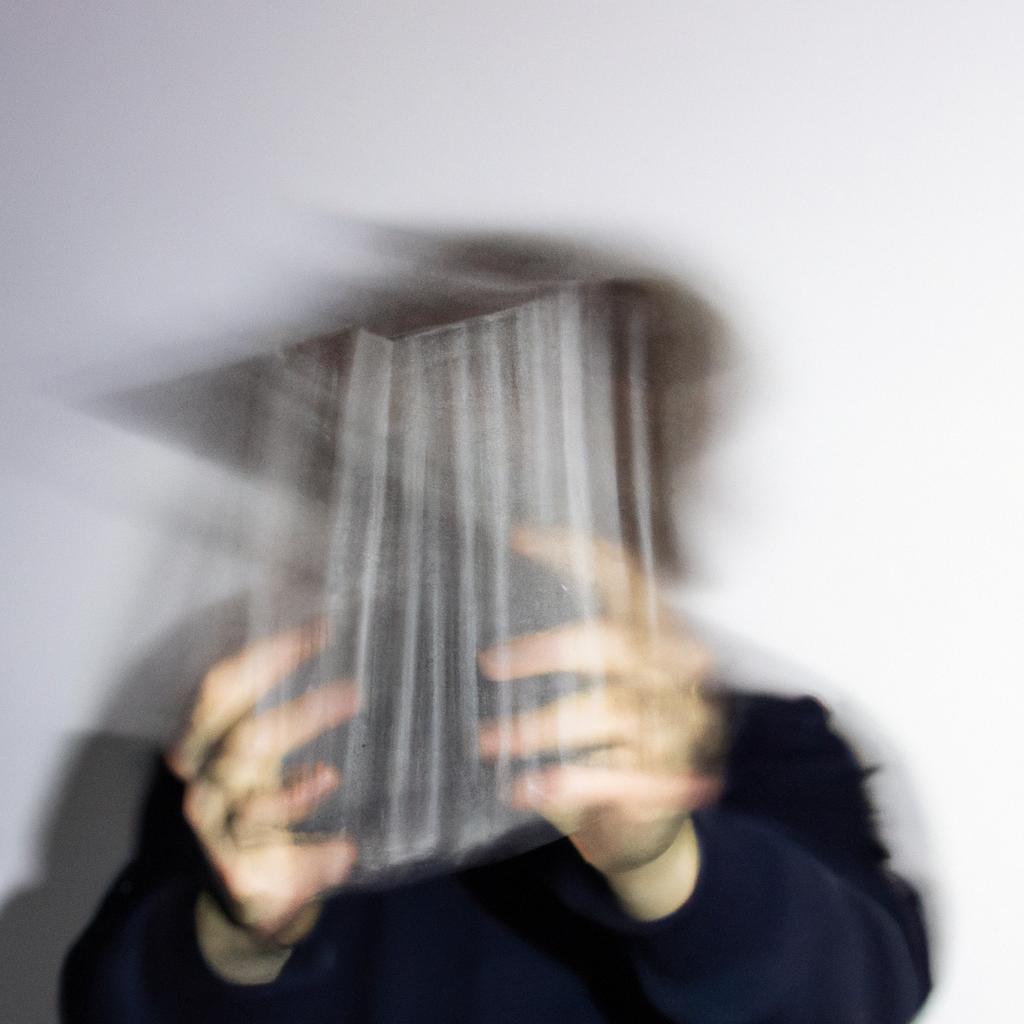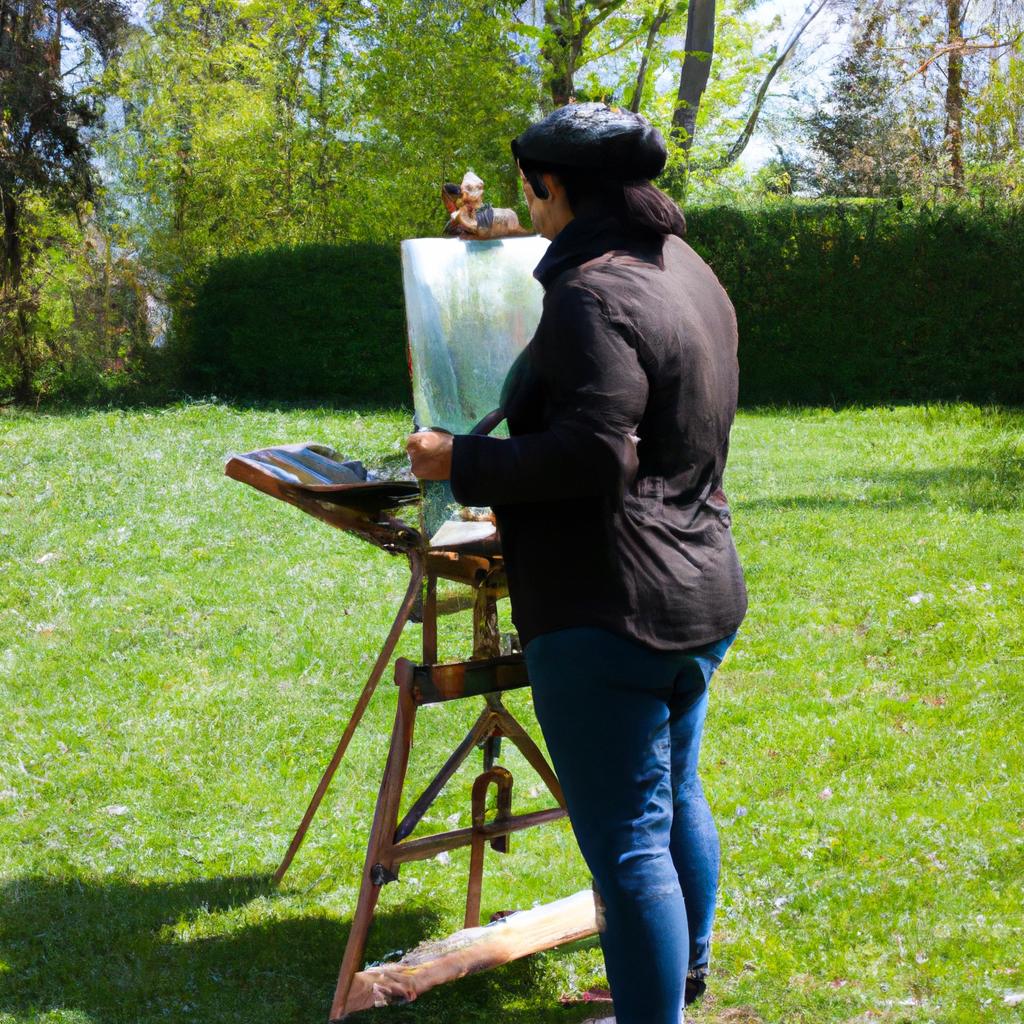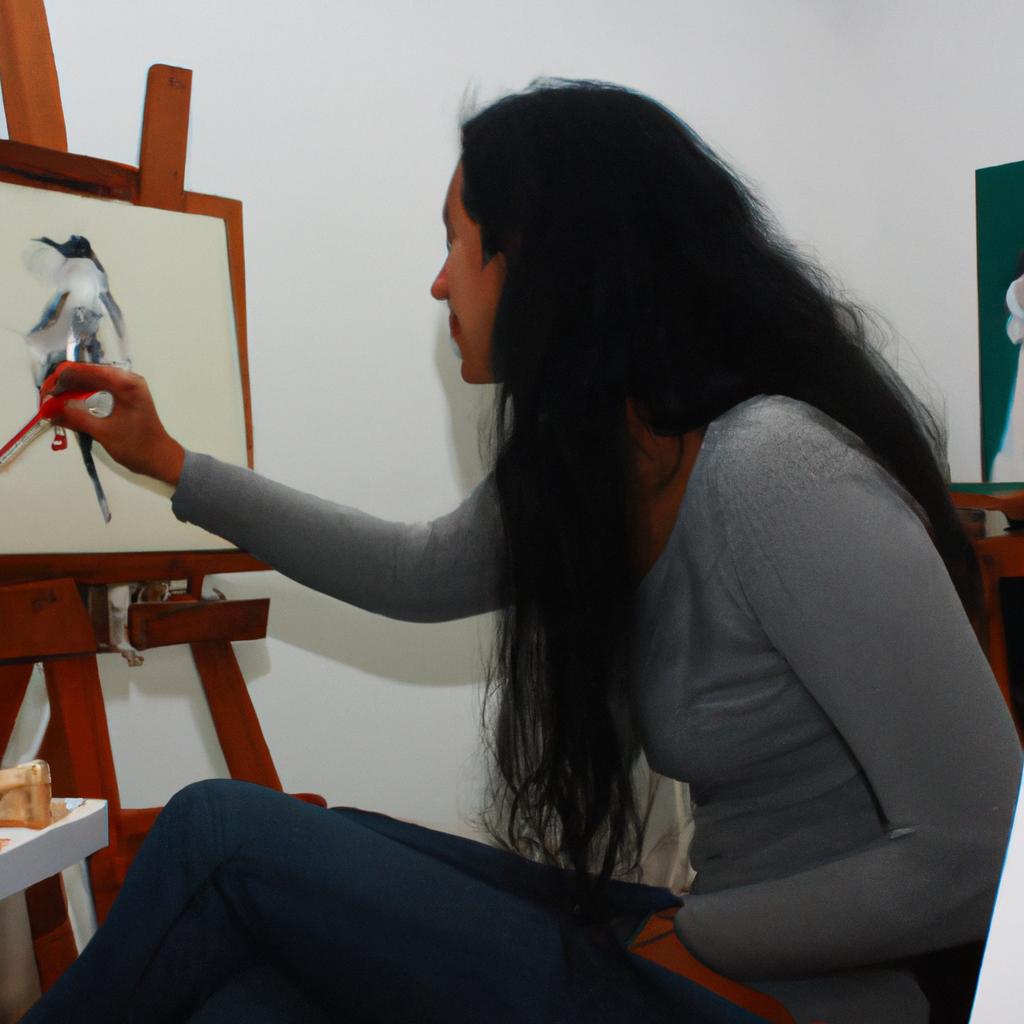Abstract art has long been a subject of fascination, with its unconventional forms and enigmatic expressions captivating artists and viewers alike. In recent years, an intriguing intersection between abstract art and the world of movies has emerged, leading to thought-provoking collaborations and visually stunning cinematic experiences. This article explores this unique confluence, examining how abstract art influences filmmaking techniques and narratives, and how movies in turn draw inspiration from the realm of abstract expression.
One compelling example that highlights this convergence is the critically acclaimed film “Birdman” (2014), directed by Alejandro González Iñárritu. The movie seamlessly integrates elements of abstraction into its narrative structure, employing complex visual symbolism to delve into the psyche of its protagonist Riggan Thomson, played by Michael Keaton. Through a series of surrealistic sequences characterized by distorted perspectives and dreamlike imagery, “Birdman” blurs the boundaries between reality and illusion, mirroring the inherent ambiguity often found in abstract artistic compositions. By interweaving these artistic devices within its storytelling framework, the film not only enhances its thematic depth but also challenges traditional notions of cinema as a medium for concrete representation.
The Origins of Abstract Art
One of the most influential movements in the history of art, abstract art emerged in the late 19th and early 20th centuries as a radical departure from traditional representational forms. It sought to challenge conventional notions of artistic representation by focusing on non-representational elements such as color, shape, line, and form. An example that epitomizes this movement is Wassily Kandinsky’s Composition VII (1913), where he explored the expressive potential of pure abstraction.
Abstract art had its roots in various artistic developments and philosophical ideas. The rise of industrialization and urbanization during the late 19th century led artists to question established norms and seek new ways to express their experiences in an increasingly modern world. In addition, influences from Eastern philosophies, such as Zen Buddhism and Taoism, which emphasized spiritual exploration through simplicity and emptiness, also played a significant role in shaping abstract art.
To better understand the origins of abstract art, it is essential to consider key factors that contributed to its emergence:
- Cultural Shift: The changing socio-cultural landscape fueled a desire among artists to break away from academic traditions and explore uncharted territories.
- Technological Advancements: New materials like acrylic paints became widely available, enabling artists to experiment with different techniques and push boundaries.
- Intellectual Discourse: Intellectual debates surrounding perception, reality, and aesthetics influenced artists’ conceptual frameworks for creating non-representational works.
- Emotional Expression: Artists sought emotional liberation by delving into subjective experiences rather than merely depicting external reality.
| Factor | Impact |
|---|---|
| Cultural Shift | Challenged conventional norms; encouraged experimentation |
| Technological Advancements | Provided new tools for creative expression |
| Intellectual Discourse | Shaped artists’ theoretical frameworks |
| Emotional Expression | Facilitated deeper introspection and personal exploration of emotions |
The origins of abstract art are multifaceted, resulting from a complex interplay between cultural, technological, intellectual, and emotional factors. This movement not only revolutionized the artistic landscape but also paved the way for future developments in various art forms. In the subsequent section on “Abstract Art Movements,” we will delve further into how these early origins laid the groundwork for diverse artistic approaches within the realm of abstraction.
Abstract Art Movements
Abstract art has had a significant impact on various forms of expression, extending its influence beyond the realm of traditional visual arts. One area where abstract art has found an unexpected intersection is with movies. The marriage between these two seemingly distinct artistic mediums has resulted in captivating works that challenge our perceptions and push the boundaries of creativity.
To illustrate this point, let us consider the case study of “Koyaanisqatsi,” a groundbreaking experimental film directed by Godfrey Reggio in 1982. This non-narrative documentary features stunning visuals set to a mesmerizing score composed by Philip Glass. Through clever editing techniques and unconventional camera angles, the film creates a hypnotic experience for viewers, evoking emotions through pure abstraction rather than relying on traditional storytelling methods.
When examining the relationship between abstract art and movies, several key aspects come into play:
-
Visual Language: Abstract art employs shapes, colors, lines, and textures to convey meaning or evoke certain emotional responses without explicitly representing recognizable subject matter. Similarly, movies can utilize cinematography, lighting, special effects, and editing to create visually striking compositions that communicate on a subconscious level.
-
Emotional Impact: Both abstract art and movies have the potential to elicit strong emotional reactions from their audience. By stripping away familiar imagery and embracing abstraction, artists can tap into universal human experiences and explore complex themes such as love, loss, or identity in a way that transcends language barriers.
-
Interpretation and Subjectivity: Abstract art often invites individual interpretation since there are no fixed narratives or symbolic representations guiding viewers’ understanding. In a similar vein, movies that incorporate abstract elements allow for subjective interpretations that encourage active engagement from audiences who may bring their own perspectives and experiences to the viewing process.
-
Experimental Nature: Abstract art thrives on experimentation—artists continually push boundaries by exploring new techniques and concepts. Likewise, filmmakers who embrace abstraction challenge conventional storytelling norms by experimenting with unconventional narrative structures, visual effects, and sound design.
| Abstract Art | Movies | |
|---|---|---|
| 1. | Open to Interpretation | Provokes Emotions |
| 2. | Non-representational | Visual Language |
| 3. | Experimental Techniques | Cinematography and Editing |
| 4. | Focus on Aesthetics | Evocative Soundtracks |
The intersection of abstract art and movies creates a dynamic space for artistic exploration that allows both mediums to push creative boundaries further than ever before. The ability to evoke emotions through non-representational visuals challenges viewers’ preconceived notions about storytelling and expands the possibilities of what can be achieved artistically.
Transitioning into the subsequent section about the influence of movies on abstract art, we delve deeper into how cinematic techniques have inspired artists in their quest to create innovative works that challenge traditional norms and captivate audiences worldwide.
Influence of Movies on Abstract Art
Abstract art has always been a medium through which artists express their emotions, thoughts, and ideas in unconventional ways. It is no surprise then that abstract art and movies often intersect, with filmmakers drawing inspiration from abstract art movements to create visually stunning cinematic experiences. One such example is the film “Birdman,” directed by Alejandro González Iñárritu, which incorporates elements of Abstract Expressionism to portray the protagonist’s internal struggle.
When exploring the influence of movies on abstract art, it becomes evident that there are several key connections between these two artistic forms. Firstly, both mediums strive to evoke emotional responses from their respective audiences. In abstract art, this is achieved through the use of colors, shapes, and textures that stir different feelings within viewers. Similarly, movies employ various techniques such as cinematography, editing, and sound design to elicit specific emotional reactions.
To better understand how movies have influenced abstract art, let us consider some notable examples:
- The use of rapid cuts and fragmented imagery in films like Darren Aronofsky’s “Requiem for a Dream” inspired abstract artists to experiment with similar techniques in their artwork.
- The incorporation of surrealistic elements in David Lynch’s films served as a catalyst for many artists working within the realm of abstract surrealism.
- Filmmaker Gaspar Noé’s exploration of altered states of consciousness in his movie “Enter the Void” resonated with abstract artists who sought to depict altered or heightened realities in their own work.
- The utilization of non-linear narratives in Christopher Nolan’s “Memento” influenced abstract artists to challenge traditional compositional structures and explore new ways of storytelling through visual means.
To further illustrate the relationship between movies and abstract art, consider the following table:
| Movie | Abstract Art Movement |
|---|---|
| “The Tree of Life” | Minimalism |
| “Eternal Sunshine of | Surrealism |
| the Spotless Mind” | |
| “Inception” | Op Art |
This table demonstrates how specific movies align with different abstract art movements, emphasizing the interconnectedness of these two creative realms.
With their ability to engage viewers on an emotional level and push artistic boundaries, movies have undoubtedly influenced abstract art. The next section will explore in-depth the various techniques and styles employed by abstract artists to convey their unique visions, building upon the intersection between arts and movies that we have discussed thus far.
Techniques and Styles in Abstract Art
Abstract Art: The Intersection of Arts and Movies
In the previous section, we explored the influence of movies on abstract art. Now, let us delve into the various techniques and styles employed in this unique form of artistic expression.
One notable technique used in abstract art is gestural painting. Artists such as Jackson Pollock pioneered this approach by creating dynamic compositions through spontaneous brushstrokes and drips of paint. This technique allows for a sense of movement and energy to be conveyed onto the canvas, much like how actors bring characters to life on the silver screen.
Another popular style within abstract art is color field painting. Artists like Mark Rothko focused on large fields of vibrant colors that enveloped viewers when they stood before their artwork. By using bold hues and simplified forms, these artists aimed to evoke emotional responses from their audience, just as filmmakers use lighting and color grading to elicit specific moods.
To further explore the connection between abstract art and movies, consider the following bullet points:
- Abstract art can capture intangible emotions similar to how films convey complex feelings without relying solely on dialogue.
- Both mediums invite interpretation and encourage viewers’ active engagement with the work or film’s meaning.
- Abstract art and movies often challenge traditional narratives, allowing for open-ended interpretations.
- They both have the power to transcend language barriers, offering universal experiences that resonate across cultures.
Now, let’s take a look at a table showcasing some iconic examples of abstract art influenced by movies:
| Artist | Artwork | Movie Inspiration |
|---|---|---|
| Salvador Dali | “The Persistence of Memory” | “Un Chien Andalou” |
| Piet Mondrian | “Composition II in Red” | “Broadway Boogie-Woogie” |
| Wassily Kandinsky | “Composition VII” | “Fantasia” |
| Bridget Riley | “Movement in Squares” | “2001: A Space Odyssey” |
As we can see from the table, these artists drew inspiration from various films to create their abstract masterpieces. The merging of art and movies allows for a cross-pollination of ideas, fostering new ways of expression.
In the subsequent section on “Abstract Art in the Film Industry,” we will explore how this unique form of artistic creation has found its place within movies themselves, blurring the line between reality and abstraction.
Abstract Art in Film Industry
By incorporating elements of abstraction into cinematography, filmmakers have been able to create visually stunning and thought-provoking experiences for audiences.
One notable example is the 2010 film “Inception” directed by Christopher Nolan. In this science fiction thriller, Nolan masterfully employs abstract art techniques to depict dreamscapes that blur the boundaries between reality and imagination. Through surreal landscapes and distorted perspectives, he effectively conveys the complex nature of dreams, leaving viewers mesmerized and questioning their own perceptions.
To better understand how abstract art enhances cinematic storytelling, let us explore some key ways it impacts the film industry:
- Emotional Expression: Abstract art allows filmmakers to tap into emotions on a deeper level by using visual symbolism and unconventional aesthetics. The use of bold colors, dynamic shapes, and fragmented compositions can evoke strong emotional responses from viewers.
- Narrative Ambiguity: Abstract elements within films introduce ambiguity and open up multiple interpretations. They challenge traditional linear narratives and encourage audiences to engage actively with the story, sparking discussions long after leaving the theater.
- Visual Abstraction: Incorporating abstract visuals into filmmaking adds layers of meaning beyond what words or realistic imagery alone can express. It provides directors with an opportunity to communicate complex concepts or themes through purely visual means.
- Immersive Experience: Abstract art blurs the line between spectatorship and participation. By immersing viewers in a non-representational visual language, films utilizing abstract techniques can transport audiences into unique sensory experiences that transcend traditional storytelling conventions.
To further illustrate these impacts, consider Table 1 below:
| Impact | Description |
|---|---|
| Emotional | Evokes intense feelings such as awe, excitement, confusion |
| Narrative | Challenges traditional storytelling methods, encourages audience engagement |
| Visual | Communicates abstract concepts or themes through visual language |
| Immersive | Transports viewers into a sensory experience that goes beyond conventional narrative structure |
In conclusion, the incorporation of abstract art in movies has revolutionized the way stories are told on screen. By utilizing techniques such as emotional expression, narrative ambiguity, visual abstraction, and immersive experiences, filmmakers can create powerful and thought-provoking cinematic moments. In the following section, we will explore the impact of abstract art specifically within the realm of movies and its influence on audiences’ perception and appreciation of filmic narratives.
The Impact of Abstract Art in Movies
Abstract Art in Movies: A Visual Journey
The incorporation of abstract art into the film industry has opened up new dimensions of creativity and visual storytelling. By breaking away from traditional narrative structures and embracing the power of abstraction, filmmakers have been able to push boundaries and create unique cinematic experiences that captivate audiences. One such example is the renowned director Stanley Kubrick’s masterpiece “2001: A Space Odyssey.” Through his use of abstract imagery and non-linear storytelling, Kubrick successfully conveyed a sense of awe and transcendence, immersing viewers in an otherworldly experience.
Abstract art brings a distinct aesthetic appeal to movies by challenging conventional perceptions and inviting viewers to interpret images on a more personal level. This form of artistic expression allows for a deeper emotional connection with the audience, as it prompts them to engage with their own thoughts and feelings rather than relying solely on plot-driven narratives. To further illustrate this point, consider these key aspects:
- Symbolism: Abstract art often employs symbols or metaphors that carry deep meaning beyond their literal interpretation. In films like Darren Aronofsky’s “Black Swan,” the use of abstract elements helps convey the protagonist’s internal struggle and psychological transformation.
- Atmosphere: The juxtaposition of colors, shapes, and textures in abstract art can evoke specific emotions within viewers. For instance, Lars von Trier used abstract visuals in his film “Melancholia” to create an overwhelming sense of despair and impending doom.
- Subjectivity: Abstract art encourages individual interpretation, allowing each viewer to derive their own meaning from what they see on screen. Terrence Malick’s “The Tree of Life” uses abstract sequences to explore existential questions about life, death, and spirituality.
- Experimental Techniques: Filmmakers utilizing abstract art often employ unconventional techniques such as montage editing or experimental cinematography to enhance the overall impact of their work. Christopher Nolan employed fragmented storytelling techniques influenced by abstract concepts like time manipulation in his film “Inception.”
The integration of abstract art into movies not only provides a visual spectacle but also challenges viewers to think beyond the boundaries of traditional storytelling. Through symbolism, atmosphere, subjectivity, and experimental techniques, filmmakers can create immersive experiences that transcend conventional narratives. As cinema continues to evolve, the intersection between abstract art and movies will undoubtedly yield even more captivating and thought-provoking works of artistic expression.




